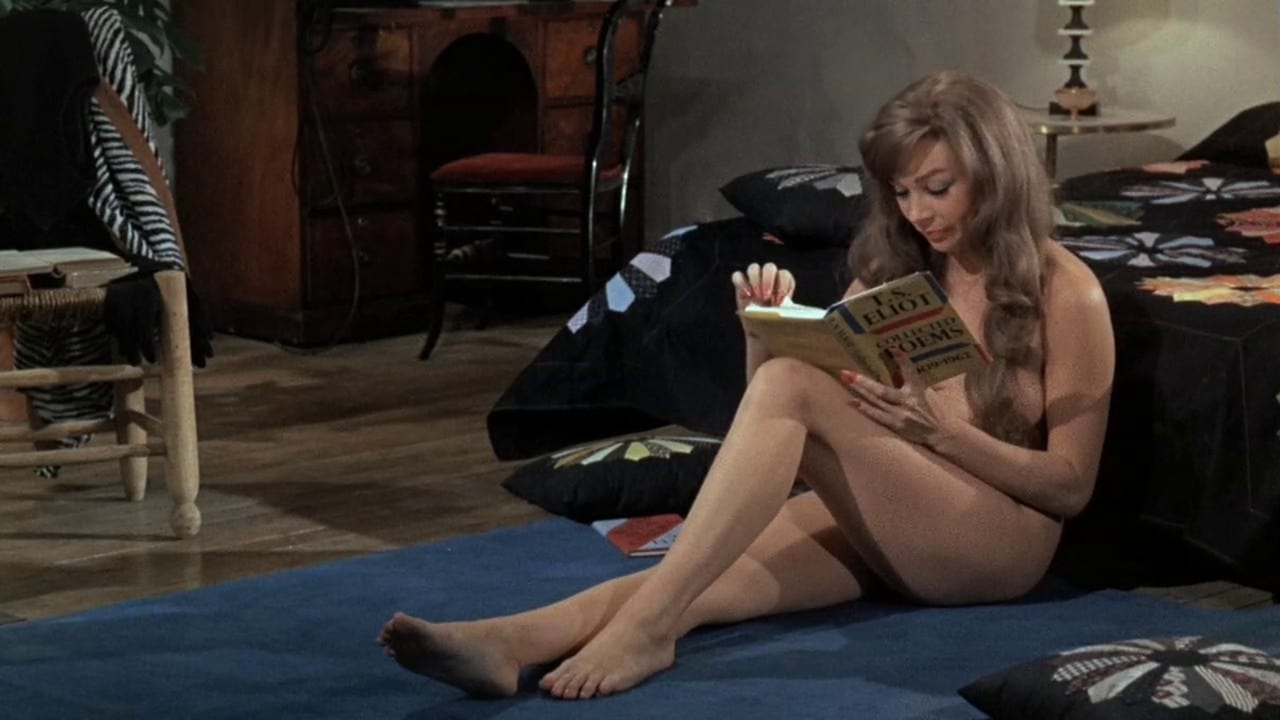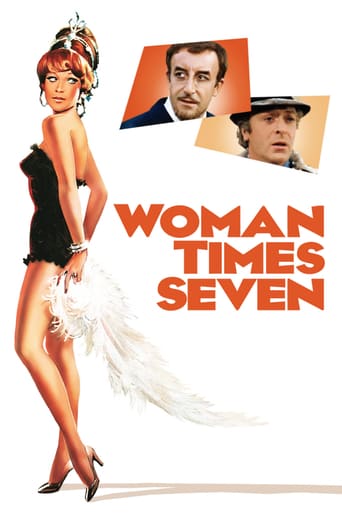



I think this is a new genre that they're all sort of working their way through it and haven't got all the kinks worked out yet but it's a genre that works for me.
View MoreNot even bad in a good way
Not sure how, but this is easily one of the best movies all summer. Multiple levels of funny, never takes itself seriously, super colorful, and creative.
View MoreIf you're interested in the topic at hand, you should just watch it and judge yourself because the reviews have gone very biased by people that didn't even watch it and just hate (or love) the creator. I liked it, it was well written, narrated, and directed and it was about a topic that interests me.
View MoreThere are two types of movies that came out of the 1960s: strange, experimental films and lusciously colored films that made later generations ask, "Were the sixties really like that?" Woman Times Seven is a mixture of both, which would be a reason to watch it, if you're interested in different types of classic films. The movie has beautiful costumes, lavish colors, and oddly 60s music; and at the same time, it's strange and experimental. Seven completely unrelated short stories—each about infidelity—are played out, all starring Shirley MacLaine! She really is darling, so if you want to see her in various wigs and furs, and with beautiful expressions from heavily made up eyes, you won't want to miss this one.The vignettes themselves aren't really all that good. Shirley has several different costars, including Peter Sellars, Alan Arkin, Rossano Brazzi, and Michael Caine. But the plots vary from silly to stalker-y to sad. It's not the best movie out there, but it won't hurt you if you want to see pretty people up on the screen.
View MoreWOMAN TIMES SEVEN is one of those portmanteau films beloved of filmmakers of the Fifties and Sixties linked by an abstract theme or authorial voice. In this case, it is adultery.Shirley MacLaine gets the chance to show off her acting talent in seven different roles ranging from a mousy homemaker to a translator-turned-vamp, a shrewish society lady, and a middle-aged Parisian pursued by a strange man. Sometimes she is more effective than others; she reveals her talent for dancing as well as nonverbal comedy. The film is quite risqué for the late Sixties, as it has her appearing nude in one of the sequences, although director De Sica ensures that she is most tastefully shot, revealing nothing of her charms for lascivious viewers.Of the seven playlets, "Funeral Procession" is quite droll, with Peter Sellers reprising his role from the previous year's WHAT'S NEW, PUSSYCAT? as a lecher trying yet failing to persuade a widow (MacLaine) to sleep with him. In "Super Simone" Lex Barker plays a successful novelist so obsessed with his fictional character Simone and her sexual exploits that he remains immune to his wife's (MacLaine's) entreaties - that is, until she initiates some outrageous stunts, including having their evening meal served by an African dressed in tribal clothing. "At the Opera" has MacLaine as a society lady fond of shouting at everyone who is eventually trumped by the sight of one of her deadliest rivals (Adrienne Corri) having the same style of dress designed for her. The anthology rounds off with Michael Caine in a nonspeaking role working for a rich Parisian (Philippe Noiret) jealous of his wife (MacLaine).The film incorporates some of the sexist values characteristic of a pre-feminist era: women mostly exist to serve their husbands, both socially as well as sexually. Yet such archaism is redeemed somewhat by the atmospheric photography (by Christian Matras) that captures Paris's romanticism and enduring attraction.
View MoreMy summary was facetious. Without good writing, a film simply isn't worth seeing--which pretty much sums up my opinion on "Woman Times Seven". It's very poorly written--quite uneven and at times annoying. The director didn't help any, as the film lacks subtlety and simply is a chore to watch. My only reason to watch it is that Peter Sellers was in it--but barely.Shirley MacLaine stars in seven different vignettes as a woman living in Europe. The shorts are supposedly funny (which they aren't) as well as a bit bawdy. I real felt sorry for the actress, as she was far too talented to be in such a lousy film. In fact, my wife kept asking me "why are you watching that STUPID film"--until finally I realized she was right and turned off this dreadful mess.
View MoreIt's always a bit sad when you remember a movie for so long, with such joy, and then finally when it comes out on DVD and you rush to view it, well, as Mr. Wolfe likes to say: "You can't go home again". I first saw this movie as a little boy, sneaking into the neighborhood theater. "Woman's Times Seven" was, after all one of those "foreign films" (though not really), and I was told that no self respecting all American boy should see it. So I was there the first day it opened. For a little boy, seeing Shirley Maclaine reading TS Elliot in the nude, or running around with heart-of-gold prostitutes was enough to proclaim this a masterpiece. For some strange reason this was a movie that didn't find its way onto regular TV, or even cable (or perhaps I just missed it), and only recently came out on DVD. So it remained as a great film in my mind all these years.But then I just saw it again. The problem is that six of the seven stories, watching them now as an "old man", just don't work. They are, more "shaggy puppy stories", than anything. Simple ideas (grieving widow being seduced in "eye shot" of her dead husband, scorned wife seeking revenge, pampered rich bitch, crazy UN translator, suicidal mistress, plain housewife trying to bring life back into her marriage, etc.) just fall apart after the first scene.Sure, I remember Lex Barker as the ultimate writer cliché two massive dogs at his side, ever lit pipe, writing sexy novels in his study wearing a smoking jacket, (and from then on wanted nothing more than to write novels myself!) but basically so much of this film is forgettable, and the endings just sort of fizzle out. The first story, with Peter Sellers, the "family friend" escorting the beautiful grieving widow, walking right behind a horse-drawn Hearst along with a party of mourners, trying to seduce her while her dead husband's body is still warm, could have been wonderful especially if they had allowed Sellers to do his own thing. But director De Sica (who plays a cameo in this story as one of the mourners) keeps it cold, and by the numbers. There is no motivation for what Maclaine decides to do at the end of this story. This seems to be a problem with the next five stories, their pay-offs are basically bankrupt. Sure, even as a boy I got the joke that the photo of her lover in the story where she was a UN Translator having a "night" with two horny bureaucrats, was actually Marlon Brando, but when that one gag (which, by the way, they play into the ground) becomes the highlight of what should have been a "shocking" celebration of a possible "ménage a trios", then you have problems.And when have you ever seen Alan Arkin complete wasted before?So many of the endings have this kind of self-satisfied "shrug" to them. A sort of "oh well" sensibility that seems more cop-out than pseudo existentialism. However, the reason I call this review "woman minus six", is that the movie is completely redeemed by the seventh and final story, called "Snow". A simple story, the most beautifully photographed in the streets of Paris, shows two best friends, Maclaine and Anita Ekberg on a shopping day, being pursued by what they believe to be a young smitten wannabe lover. In sweet simple scenes you follow the "suitor", (played with elegant grace by Michael Caine and without one word of dialogue!) as he seems to pursue these two women. When they decide to split up after lunch to see which one he truly is after (although Ekberg does say: "Maybe he wants us both, he could be one of those moderns) Maclaine. to her joy, finds that he continues to follower her.I won't spoil the ending, but this truly was a pure, finely crafted story, which says more about women, their needs, hopes, desires, fears and fantasy's, in fifteen minutes, than most movies do in two hours. And finally Ortolani's theme which has been repeated through every story, also finally makes sense. Everything comes together in this last story. I'm sure there is no coincidence that it was placed last. They must have know it was the best. If only they had realized that, and thrown the other six out and started over using "Snow" as their bar to try and rise above.
View More